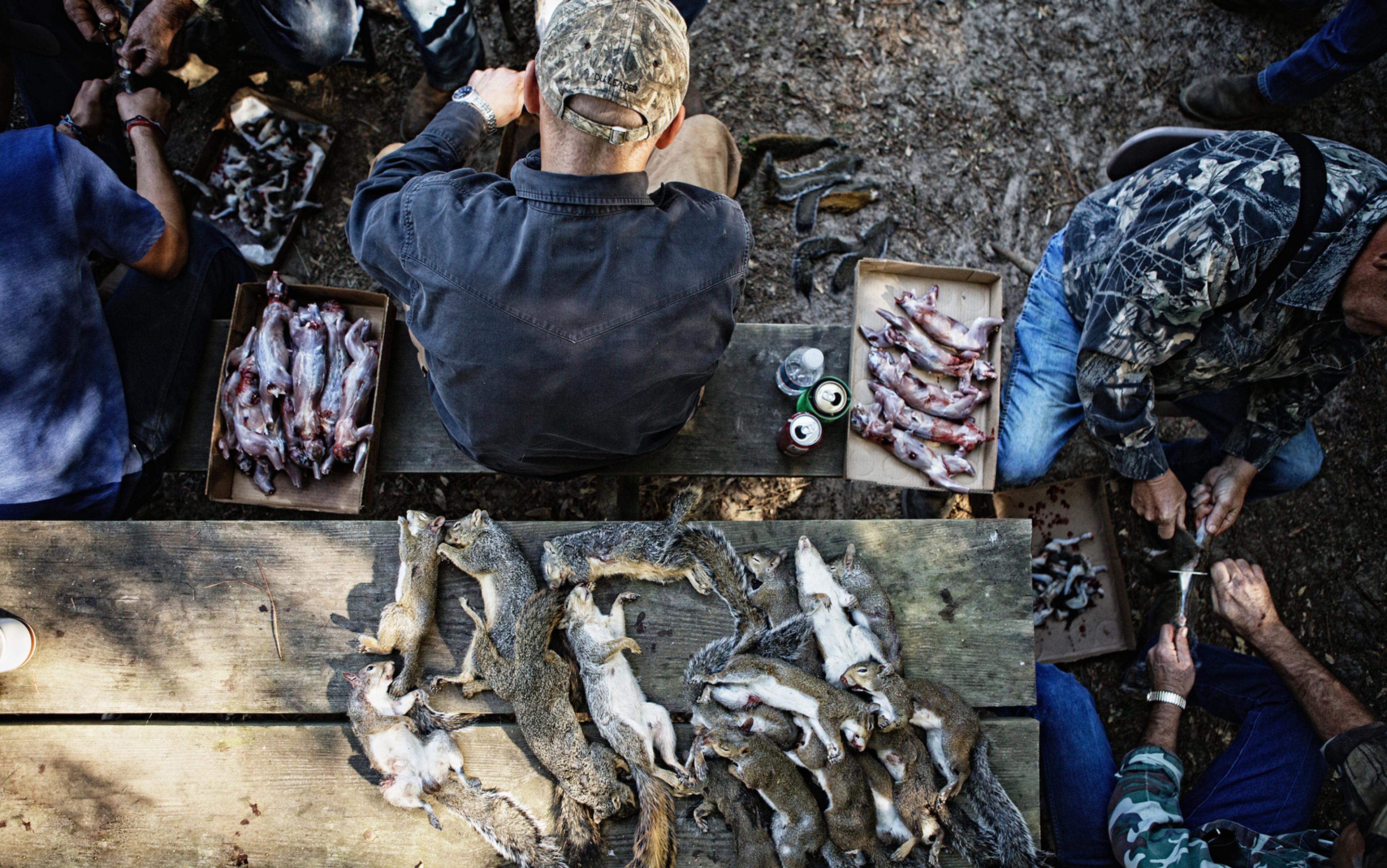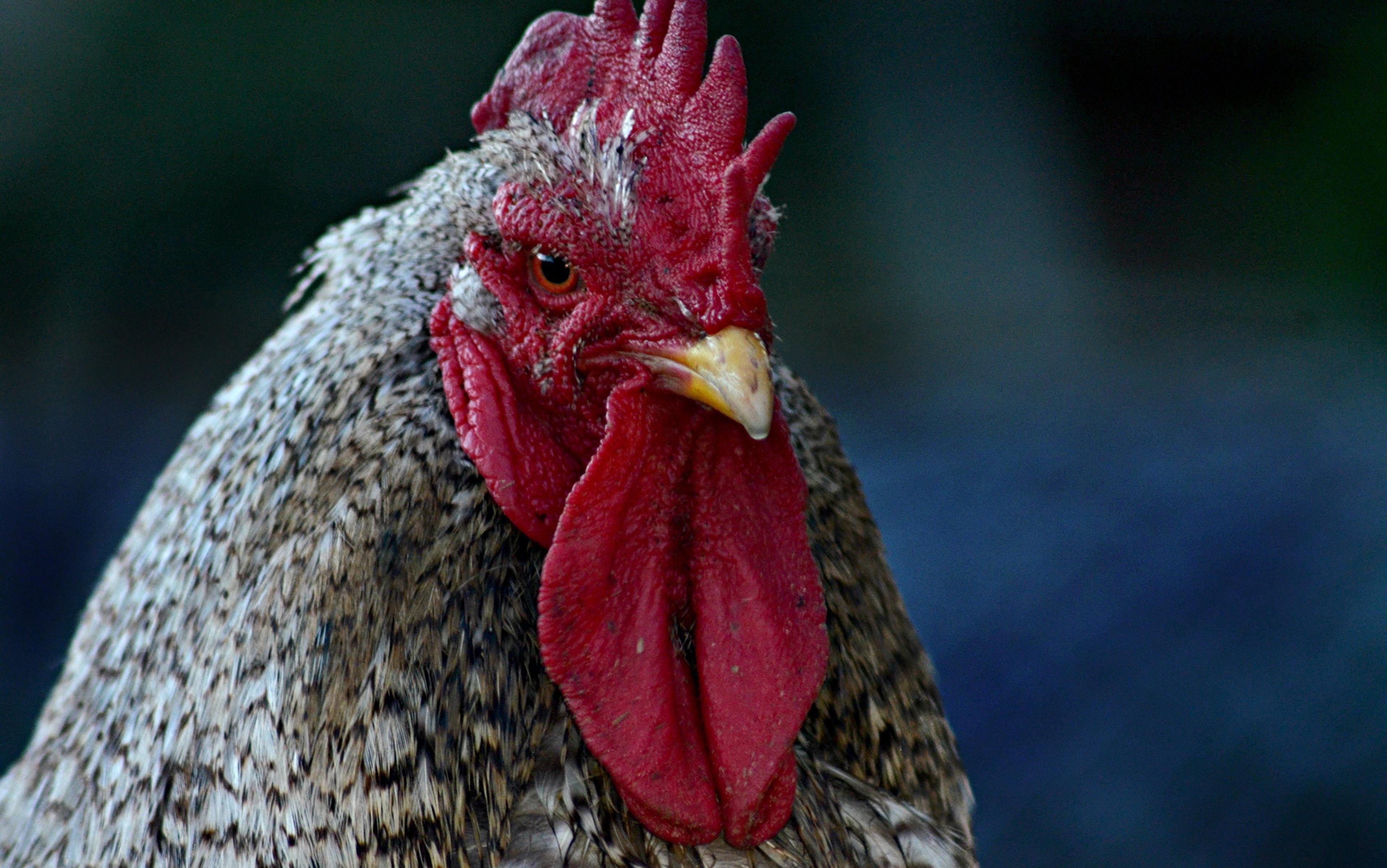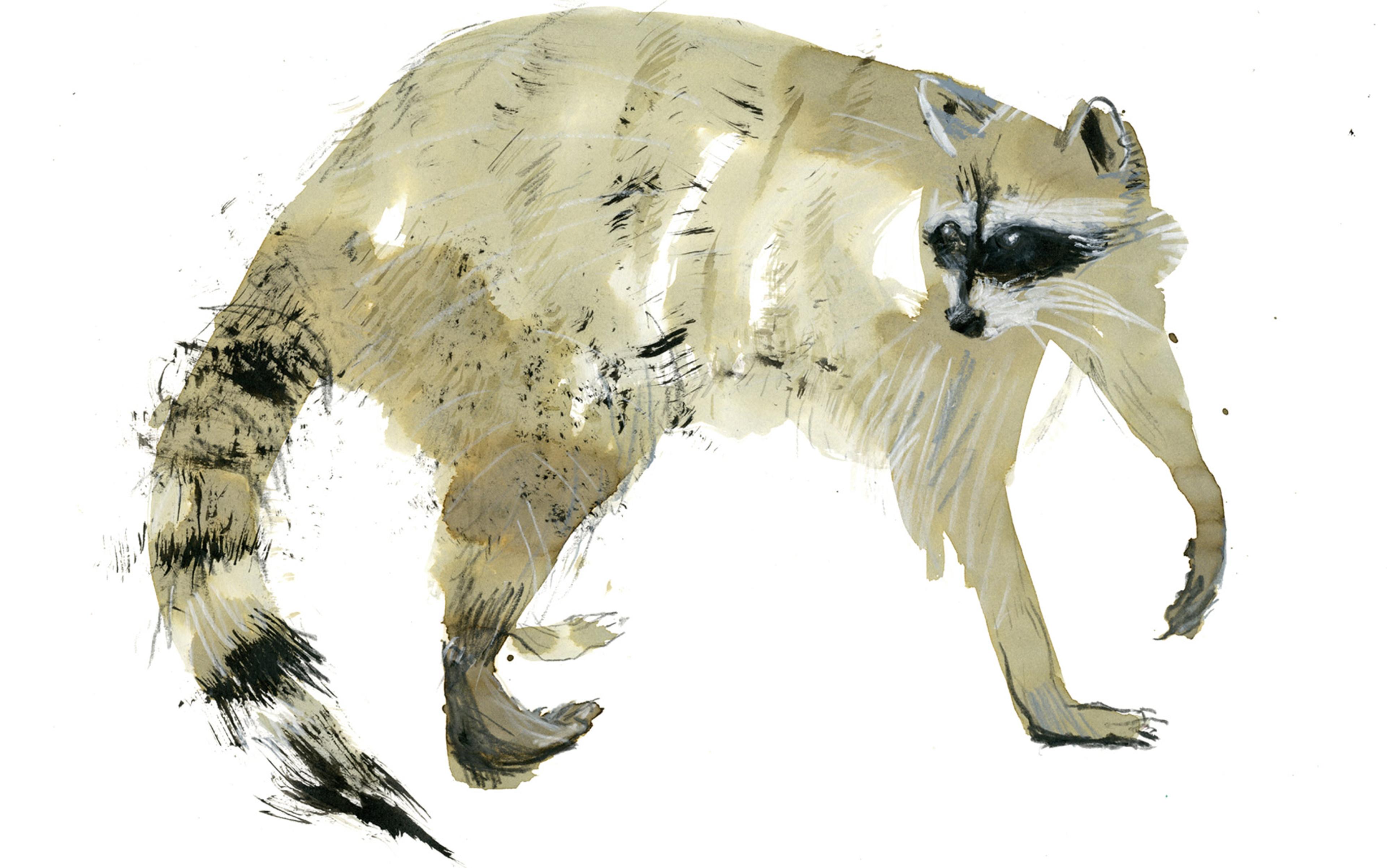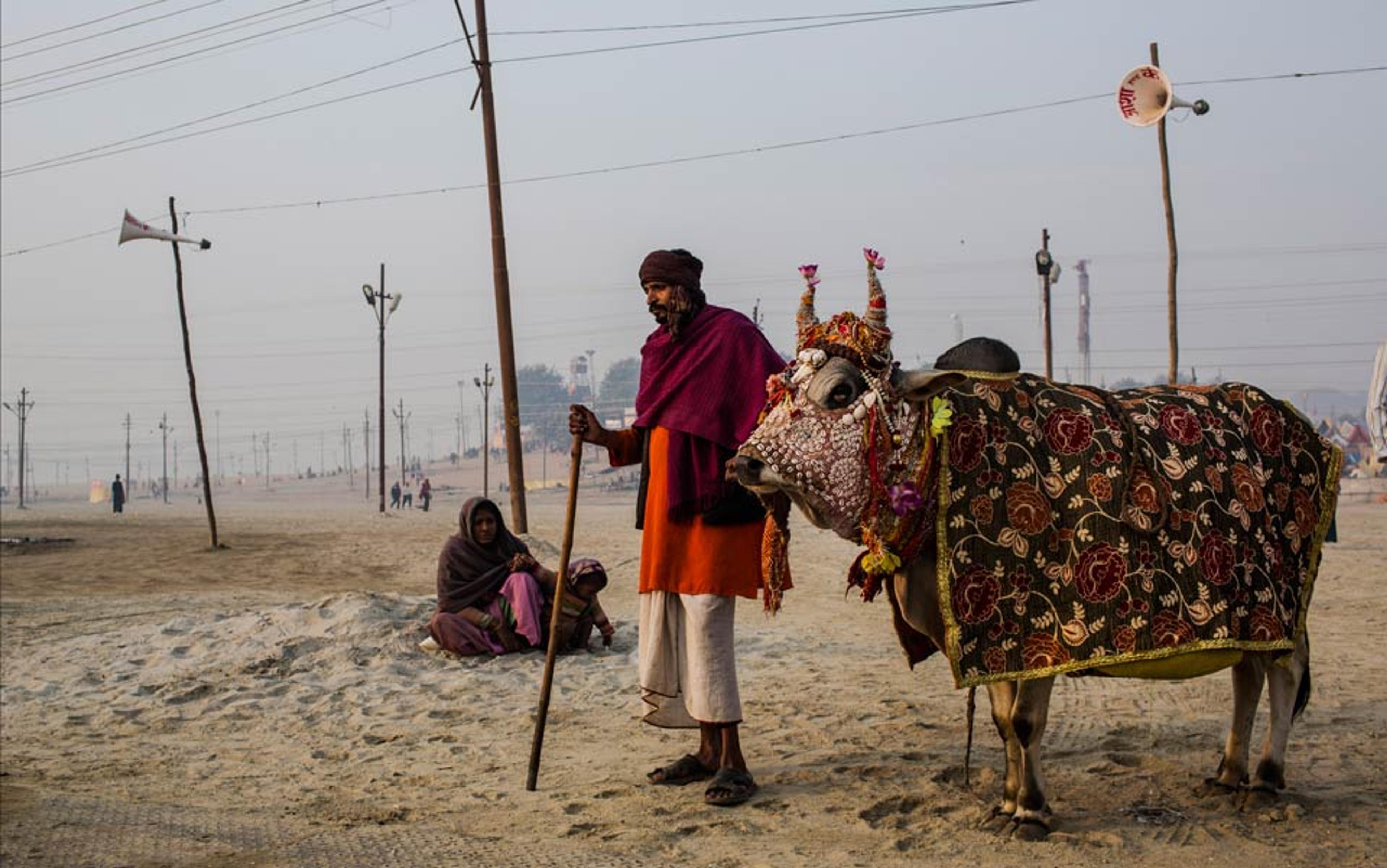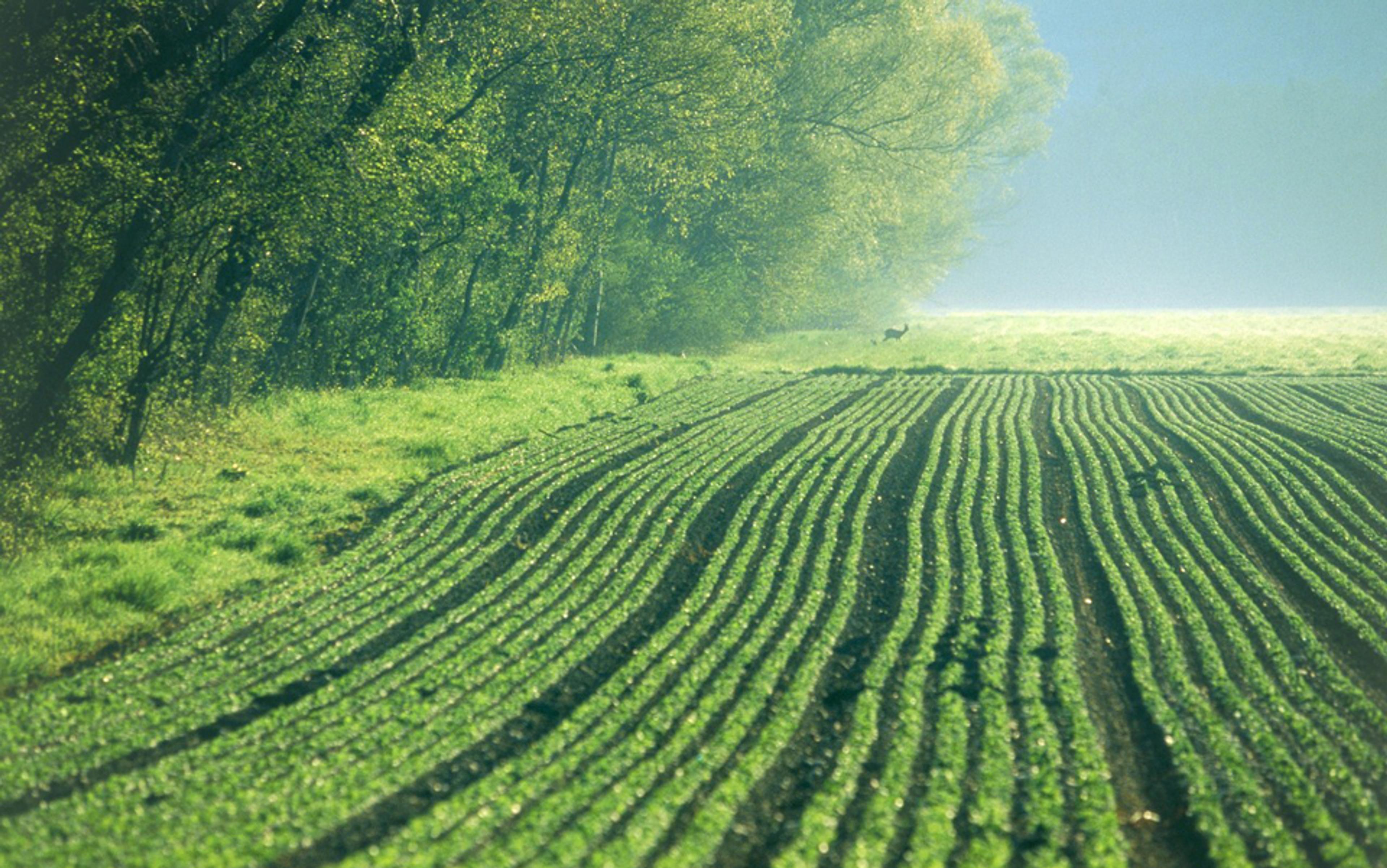The skin did not come off like a sweater, as I’d been told it would. I’d looked at how to do it in the classic Joy of Cooking, figuring the directions for squirrel couldn’t be much different from rabbit: hook it through the heels, yank the skin down to its paws. I didn’t have a hook, but even the falconer, Chris Davis, who had given me this squirrel, made it seem so simple – use scissors, he’d said, and snip horizontally into each side from the gaping hole where he’d gutted it, grab the corners of the soft fluffy pelt and pull up. Pull down. Voilà.
Sitting out by the fire pit in my back yard on a late November evening, my fingers grew stiff and numb as I pulled at layers of epithelial tissue I could not see so much as sense, subcutaneous membranes of iridescent silver visible only when I shone my headlamp just right. I could see places where the talons of the hawk that had caught the squirrel had punctured into the muscle, bruising it. Little by little, I worked the rich gray pelt down and away from the purple muscles, snipped away the durable membranes, and turned the small mammal from one piece into two.
I snipped off the head and feet with a pair of shears and buried them in my compost pile. Yesterday, when Chris had given me the squirrel, the eyes had been wide-open and filmy white. I was grateful that they’d shrunk to nearly closed overnight. I’d hardly noticed the face as I skinned, but I might have if it still had the demon-ish pale glare. The task was engrossing, a science project, or dinner preparation, a little of each I suppose.
The pelt was now one loose piece, intact except for one place where I’d accidently cut through with the scissors. It went into one Ziploc bag to be salted, while the rest of it – the body or the carcass (what does one call it at this point in the process?) – got a quick bath beneath the garden hose, and went into another bag and then into the refrigerator for another day of tenderising, for the mysterious bacteria to do its work to render the flesh from muscle into meat.
I did not have anything to do with the killing of this squirrel. I wasn’t even present for its death. I’d gone out with Chris, who hunts with Harris hawks, as part of another project I was working on about falconry. There was a good possibility that one of his hawks would catch a squirrel, and so I asked if I could keep it if that happened. But the hawks we hunted with didn’t catch any squirrels that day. Chris happened to have some in his van from the previous day’s hunt, already gutted with snipped-off tails, which he’d given to the kids he’d brought out hunting as good-luck talismans.
When Chris’ hawks land on a kill, he moves in quickly, gives the birds a piece of raw meat to distract and reward them. Then he wraps his hand around the squirrel, collapsing its ribs to suffocate it, because the hawks’ talons won’t kill it quickly enough, even if the bird has begun to tear into the still-living animal.
As I butchered and prepared the squirrel for eating, I realised how much the follow-up work is often overlooked. The hunters in my family always emphasised the kill, the moments of being in the deep silent woods, the story of the first buck snort, the chase, the final shot. Stories of sitting stock-still in deer stands, or crawling on hands and knees after a blood trail.
During my childhood, if my brother or father got a deer, they dragged it out of the woods and drove it home, gutting it and hanging it from a maple tree in our backyard. For two days my father and brother would re-tell the story, the narrative itself slowly separating from the carcass dangling by rope from over our stone patio. The animal would be an animal only in memory. Nobody talked about the stiffening carcass that slowly creaked in the wind. It was a period of time where I couldn’t have friends over, because I couldn’t respond to their incredulous cries of Is that real?!
Then, suddenly, the deer would be gone, reappearing days later as white parcels in our basement freezer, each stamped with the cut – roast, shank meat, tenderloin. Over the course of the year we’d open the parcels, the meat disappearing into us in the way of steaks, stews and burgers. The story of the hunt would eventually fade too, except for the few that stood out – like the time my father started gutting one buck and it suddenly awoke, legs thrashing about. But usually, the animal, its meat and the memory of it, would just dissolve.
What was left out was the butchering. Butcher, as a profession, isn’t exactly a title that many people aspire to anymore. Not many want to be the ones wearing the bloody apron, carrying the meat-cleaver, moseying between the swinging carcasses with their layers of waxy white fat, the meat somewhat – but not entirely – unrecognisable from its living form. Or, maybe they would like to do that if the profession still existed as such. Now, to butcher, is to be on an assembly line – working the gun, or a hose, or a knife, over and over and over. Like so much else having to do with our contemporary diets, the art of butchering has become industrial, sterile, factory-line-style dismemberment that hardly seems to represent food.
Like any post-vegetarian, I relished, somewhat guiltily, the taste of meat again
My own desire to trap, skin and eat a mammal – a rabbit – began after I spent several months living on a small meat farm in the early 2000s. Before that, I’d been a vegetarian college student, and before that an uninformed omnivore, a ‘normal eater’ I suppose you could say. Except for the years that my father or brother shot a deer, our meat came from the store in Styrofoam packages, tightly wrapped. The only time we ate meat that resembled the animal it came from was our roasted Thanksgiving turkeys.
College had brought me to the west, a trip that takes the driver through massive feedlots in Texas, where the stench of animal sticks with you for miles. It brought me into awareness: the ecological crisis of industrially-raised animals, the social injustice of that industry’s employment tactics.
So when I landed on a small organic farm back east, I was hesitant about meat. But it was clear that the small flock of sheep and the modest herd of beef cattle were not the destructive empires of the west and midwest. Like any post-vegetarian, I relished, somewhat guiltily, the taste of meat again. But even on the farm, the butchering was done off-site at a slaughterhouse. We would round up pigs and load them into a trailer, and days later we’d pack frozen bricks of meat into the chest freezer, labelled with the farm’s logo. Even then I wondered at the jobs of the people who worked at the slaughterhouse, how they’d chosen what I saw then as such unfortunate work. I couldn’t help but wonder, who would want to do that?
A squirrel’s body is a magnificent machine. Peeled, it resembles an outstretched frog, the muscle strong and sinewy, and deep purpley-red. My mother, once recalling a relative who used to make squirrel stew, shivers at the idea of skinned squirrels – they look to her like human foetuses. There was something human-like about the carcass that I had tucked into the Ziploc bag, but the muscles were too developed to make me think of anything infantile or foetal.
Rather, it looked miniature – the flayed body of the world’s smallest weight-lifter. The ribs were strangely flat and flexible, not a sturdy cage like ours, but more like a set of curved reeds, made to fold together so the animal can squeeze into a tight space. Made, for example, to flatten itself against the cavity of a tree to escape a hawk’s outstretched talons. The ribs need to expand as the animal dangles from its back feet to eat maple seeds high up in a tree, and must be soft enough to endure the blow when the squirrel falls to the ground, as I’ve seen happen many times.
I marvelled at the acrobatic athleticism of this species as I prepared the animal for eating. It was my last look at the creature as a whole. I snipped it into quarters, front legs, hind legs, and then portioned off two medallions of meat from the midsection that weren’t much more than thin flaps. I put the pieces into a bowl of red wine and onions to sit overnight.
The next evening I removed the pieces, now a deep magenta. I pan-seared the meat, made a quick gravy in the pan. I added the wine marinade, several prunes and sautéed mushrooms. The meat cooked on the stovetop for a half hour in this wine sauce until it was dark and tender, the sauce a rich brown. I served up two portions over rice, one for me, one for my boyfriend, Ben. When it came time to eat it, I’d almost forgotten that this was what it was about.
The close attention to my task caused me to forget about the killing. I did not feel bad. I was too busy, and I had to be sure I did it right
It wasn’t that I was scared to eat squirrel because it would taste gross or because I felt bad. It was more the mystery of eating anything wild. This squirrel had come from a patch of woods near the dormitories on the University of Massachusetts at Amherst campus. While it lived in a stand of old oaks and likely subsisted on acorns, there was still the possibility that it scavenged in the dumpsters, or worse, had consumed rodenticide. But the animal looked perfectly healthy. So I ate. Every last piece of meat on my plate, even sucking meat off the bones like I would with fried chicken. It tasted to me like rabbit. The meat was dark and what some might call gamey, although I think that word is used as a catch-all for a plethora of various flavours that meat naturally has. It was unremarkable, a little dry. But when I was done I felt satisfied.
A common discussion among post-vegetarians, at least the hippie-ish, environmentally-minded ones in whose company I often find myself, is: if we are to eat the meat of an animal, should we hold ourselves responsible for its death? Yet ending up in a situation where one can even get the chance to kill an animal, whether domestic or wild, is much more difficult than talking about it. This past fall, I helped some friends slaughter their small flock of chickens. One friend grabbed them from a box where he’d quarantined them, hung them upside down in a funnel and slit the throats. He’d wait several minutes for the bird to stop thrashing and the blood to drain into a bucket. Then he’d plunge it into a pot of water heated to 150 degrees Fahrenheit. The birds would then be hung from a piece of wire where Ben and I would pluck, the wet feathers pulling easily from the skin. Once plucked, we’d pass them to our friend at the end of the line who would eviscerate, behead, de-foot, and then plunge the carcasses into an ice bath.
I did not do any of the actual killing. I was close enough to know that I could have done it, but suddenly, being the one wielding the knife seemed less significant – each role was important in preparing the bird to be food. As with the squirrel skinning, I became engrossed in the task. At first, the feeling of wrongdoing hung like a fog over the experience – nobody likes watching an animal die – but it quickly dissipated, replaced with something much more innate, much more focused. The close attention to my task caused me to forget about the killing. I did not feel bad. I was too busy, and I had to be sure I did it right. If I waited too long, the skin would grow stiff, and the plucking would become difficult. If I was too careless, I might leave behind the pins of feathers just below the skin – unpleasant when it came time to cook the bird.
The moral implications of slaughtering animals have plagued Western civilisations for centuries. It’s hard to know how much of our contemporary butchering practices have evolved for public health reasons, and how much because we are shamed by the act of killing, especially large-scale killing.
The sociologist Amy Fitzgerald outlines the history of this evolution in her article, ‘A Social History of the Slaughterhouse: From Inception to Contemporary Implications’ (2010). Fitzgerald cites the first public slaughterhouse dating back to 1662 in the United States, and in 1676 slaughterhouses in New York City were moved from the city’s centre to less densely populated regions. And it was in the early 18th century in both Europe and the US that these public slaughterhouses became preferable to private ones because they removed the ‘morally dangerous’ work of animal slaughter from easy view.
If the first step was removing animal slaughter from the backyards and barns of civilians, out of the public eye, the second was the rise of factory-style meat processing. Fitzgerald draws on Upton Sinclair’s famous novel The Jungle (1906), which portrays lives of immigrant meat packers in Chicago’s infamous Stock Yard. With the industrial revolution came assembly-line style employment. Animal slaughtering is said to be the first ‘mass-production industry’ in the US – Henry Ford partially adopted the mechanisms in his factories from meatpacking factories. With that came expendable employees and a culture of meat-factory ghettos on the city’s edges where immigrants lived in destitution, as Sinclair details. It was a public health and human rights disaster.
In the time it took me to skin, butcher and cook my squirrel, nearly 10,000 cattle had been killed and processed in just one factory
The mid-20th century brought strikes and labour organising, and, for a stretch of time, working in the meat industry was a lucrative job. But the power of unions diminished as the 20th century drew to a close. Instead of being outsourced to foreign countries as happened with other industries, the meat business relocated to the Southern US, where unions were weak. Well-paying mid-century meat jobs had gone mostly to white men, but the new meat business employed racial minorities and immigrants. The companies regained power, merging, and a handful created a monopoly on the industry. The work was increasingly industrialised, the positions less and less skilled, the workers once again as expendable and vulnerable as the fictionalised characters in The Jungle.
In the past several decades, the world’s meat consumption has risen, reaching a new peak in 2002 at 219 lbs (just over 99 kg) per person, Fitzgerald says. Slaughtering methods have become even more efficient and prices for meat have actually dropped, reaching the lowest in 50 years. The number of meat-processing facilities has decreased, but the number of animals being processed has increased, meaning more animals in concentrated numbers – both living and dead – and more environmental health issues, such as manure levels becoming toxically high. In today’s most efficient factories, at least in the US, 400 cattle can be processed per hour. In the time it took me to skin, butcher and cook my squirrel, nearly 10,000 cattle had been killed and processed in just one factory.
We live in what Richard Bulliet, a historian at Columbia University, calls a new era of ‘postdomesticity’ – people live far away, both physically and psychologically, from the animals that produce the food, fibre and hides they depend on. Yet they maintain very close relationships with companion animals – pets – often relating to them as if they were human. In Hunters, Herders, and Hamburgers: The Past and Future of Human-Animal Relations (2005), Bulliet comments that people continue ‘to consume animal products in abundance, but psychologically, its members experience feelings of guilt, shame, and disgust when they think (as seldom as possible) about the industrial processes by which domestic animals are rendered into products and about how those products come to market’.
We all know, or are, these people – the ones who’d rather buy our meat frozen, indiscernible from the animal it was, who brush off the family vegetarian at holidays with a Don’t ruin it for everybody else! The same people who might cry when running over a squirrel on the way home from the grocery store.
Bulliet traces the recent divide, particularly in the US, to an obvious source: in 1900, 40 per cent of people in the US lived on farms. By 1990, 2 per cent did. In 1900, people were doing what my chicken-slaughtering friends do – slaying animals in their backyards. Regulations had been put in place for the slaughter of animals to be sold at a market, hence the public abattoirs and slaughterhouses; but people who lived on remote farms and raised animals, a large percentage of the population, still did it themselves.
Children, who are naturally curious about sexual acts, would see animals copulating regularly
This meant exposure to blood and viscera and a solid understanding of what a skinned animal looks like; it meant knowing how meat is hewn from a carcass. It is easy to understand how this way of life afforded a better comprehension of what we eat and how it dies. What farm slaughter also exposed people to, says Bulliet, was how these animals not just died, but lived, including how they reproduced.
Children, who are naturally curious about sexual acts, would see animals copulating regularly. Living on the meat farm, I knew this would be a regular occurrence. What I didn’t realise was how varied and curious each species’ anatomy was – the frightening corkscrew penis of pigs, the way a grandmother cow would make no qualms about mounting her granddaughter, still a calf, when either was in oestrus. I became more familiar with birth, with the prolapsed uteri of sheep, and the death that sometimes followed.
When this regular exposure to sex and death diminished in the US with the rise of industrial agriculture, Bulliet claims that in order to find another outlet for these curiosities, the US and other Western, postdomestic societies have developed a fascination with sex and blood. The 1960s was the era of free love, and the 1970s – the beginning of postdomesticity – saw an exploding porn industry. The 1970s and ’80s brought slasher flicks such as The Texas Chainsaw Massacre, then A Nightmare on Elm Street. It doesn’t have so much to do with our degrading morals, but rather that fantasy has replaced our closeness to the visceral, the bloody. In short, our craving for meat is related to our craving for sex and gore.
I don’t think my experience with the squirrel filled a primitive desire to get my hands bloody. Instead, the task involved me in death, in meat, in food. The way I see it, it’s not that there’s a desire for the blood and gore, but rather we’re hardwired to deal with the blood and gore, and when that innate machinery goes unused – as it does in a postdomestic society – humans are left with a gap, with something missing.
If I were to kill an animal, it would be difficult for my mind to wander elsewhere. I would be completely in tune with this animal; I would want to be sure its death was as swift as possible. If I were tasked with punching a hole into the heads of 400 animals every hour, there’s the possibility that my mind would wander, that I would become desensitised, that death would come to mean something else entirely. But when involved in small deaths, in backyard slaughter and butchery, it seems to me the effect is the exact opposite of the fears that started to burgeon during the Enlightenment – the fear that killing animals would make men prone to violence. Butchering animals has made me more sensitive, more aware.
In the past few years, my father has taken to butchering his own deer once more. He didn’t like the way the butcher did it. It was lazy cutting, he said, chopping through bones rather than carefully slicing the meat into roasts. Halfway through shotgun season, I visited my parents to help them with the doe my father got, although I ended up watching more than helping.
poke a hole through the hide, tie one end of a rope to it, and the other end to your car bumper. Back up slowly. Zoop – off like a jacket
It was a bitter cold day, and the skinned animal hung from a tree outside. It looked fake, the tallow-like fat hardened in the December cold. My dad stood in his old camouflage jacket that he’d had since I could remember, the zipper long broken. He was working fast, and a little sloppily, because his hands got cold so quickly. I was barely out of the car when he said to me: ‘Let me show you how to cut the front shoulder.’ He pushed his knife through the meat, which made a peculiar hollow noise since it was partly frozen, and pulled slightly on the leg at the same time. When the hunk he wanted came off, we walked to the basement door. My mother opened it, and my dad put the meat on a strip of wood he’d put across the washer and dryer; a strip of cardboard protected the dials from the mess.
He held his hands out to the side, and tipped his head towards my mother. ‘Hat,’ he said, and she pulled the gray knit cap from his head. Two patches of hair on either side of his head stood straight up, touching in the middle. ‘Glasses,’ he said, and she took off his glasses for him, placing them on top of the stand-up freezer.
He consulted a book my mother had laid out on a drying rack. She had set up a card table with various sizes of Ziploc baggies and a sharpie.
‘Now,’ he said, turning to the meat. ‘This must be the chuck roast and this the shoulder roast.’ The rest, he said, the smaller groups of muscles that made up the slender part of the leg, which, skinned, strongly resembled a human forearm, was shank meat. There was so much silver skin between the muscles of the shank, so that meat would best be ground, or chopped up for stew meat.
As he began to cut, I flipped through the pages of the book. The chapter on skinning proposed a revolutionary method: poke a hole through the hide, tie one end of a rope to it, and the other end to your car bumper. Back up slowly. Zoop – off like a jacket. Something about this method seemed callous – one I probably wouldn’t ever try.
Soon, the sight of blood and meat started to lose impact. My dad did all the work, cutting, separating, slicing away the silver skin. My mother held open the baggies, then labelled them, and put them on a shelf in the freezer below last year’s meat – brisket and rib meat, some of which I went home with.
Soon, it was like it was any old Sunday. A family gathered together, storing up the larder for winter.
